2008 INFINITI FX35 battery
[x] Cancel search: batteryPage 3147 of 3924
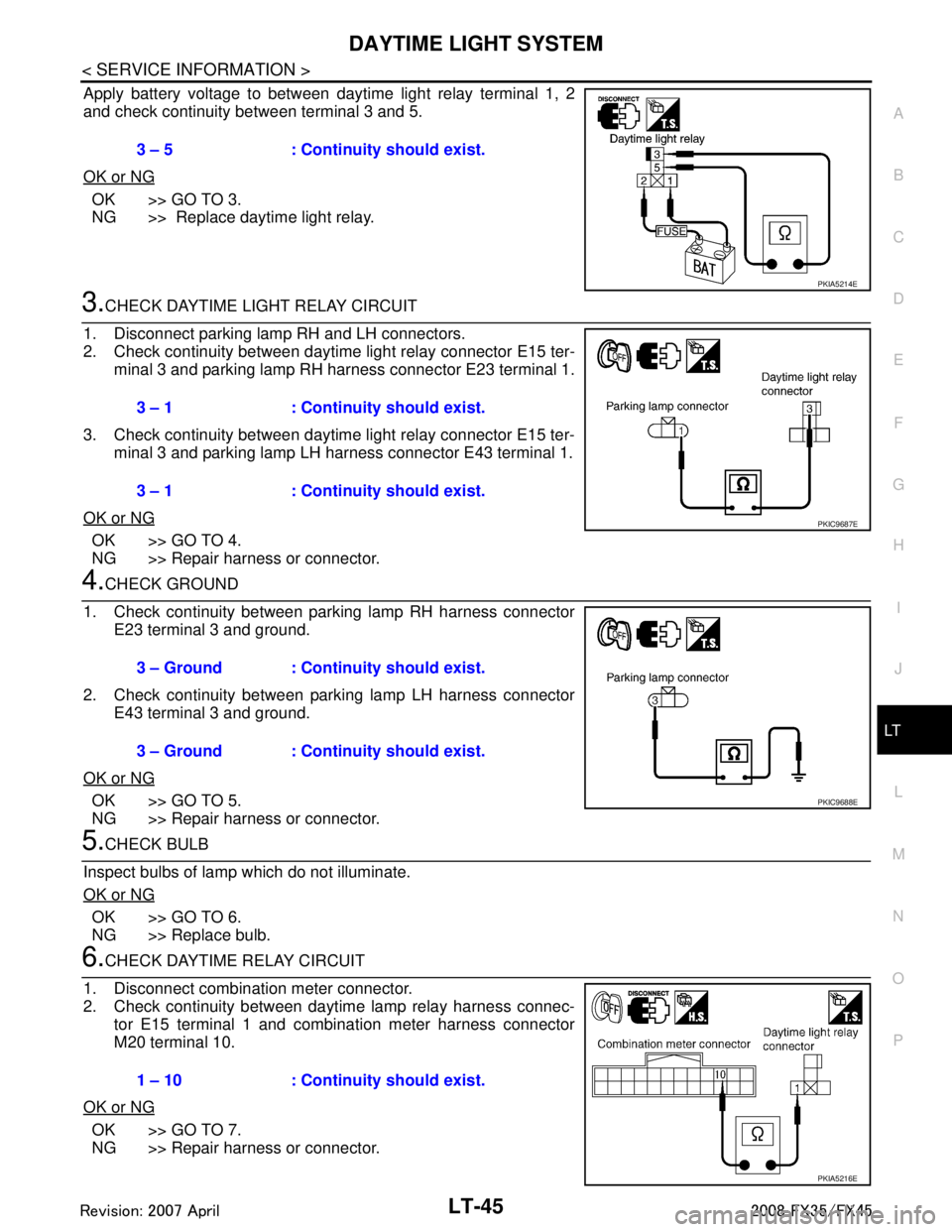
DAYTIME LIGHT SYSTEMLT-45
< SERVICE INFORMATION >
C
DE
F
G H
I
J
L
M A
B
LT
N
O P
Apply battery voltage to between daytime light relay terminal 1, 2
and check continuity between terminal 3 and 5.
OK or NG
OK >> GO TO 3.
NG >> Replace daytime light relay.
3.CHECK DAYTIME LIGHT RELAY CIRCUIT
1. Disconnect parking lamp RH and LH connectors.
2. Check continuity between daytime light relay connector E15 ter- minal 3 and parking lamp RH harness connector E23 terminal 1.
3. Check continuity between daytime light relay connector E15 ter- minal 3 and parking lamp LH harness connector E43 terminal 1.
OK or NG
OK >> GO TO 4.
NG >> Repair harness or connector.
4.CHECK GROUND
1. Check continuity between parking lamp RH harness connector E23 terminal 3 and ground.
2. Check continuity between parking lamp LH harness connector E43 terminal 3 and ground.
OK or NG
OK >> GO TO 5.
NG >> Repair harness or connector.
5.CHECK BULB
Inspect bulbs of lamp which do not illuminate.
OK or NG
OK >> GO TO 6.
NG >> Replace bulb.
6.CHECK DAYTIME RELAY CIRCUIT
1. Disconnect combination meter connector.
2. Check continuity between daytime lamp relay harness connec- tor E15 terminal 1 and combination meter harness connector
M20 terminal 10.
OK or NG
OK >> GO TO 7.
NG >> Repair harness or connector. 3 – 5 : Continui
ty should exist.
PKIA5214E
3 – 1 : Continuity should exist.
3 – 1 : Continui ty should exist.
PKIC9687E
3 – Ground : Continuity should exist.
3 – Ground : Continuity should exist.
PKIC9688E
1 – 10 : Continuity should exist.
PKIA5216E
3AA93ABC3ACD3AC03ACA3AC03AC63AC53A913A773A893A873A873A8E3A773A983AC73AC93AC03AC3
3A893A873A873A8F3A773A9D3AAF3A8A3A8C3A863A9D3AAF3A8B3A8C
Page 3155 of 3924
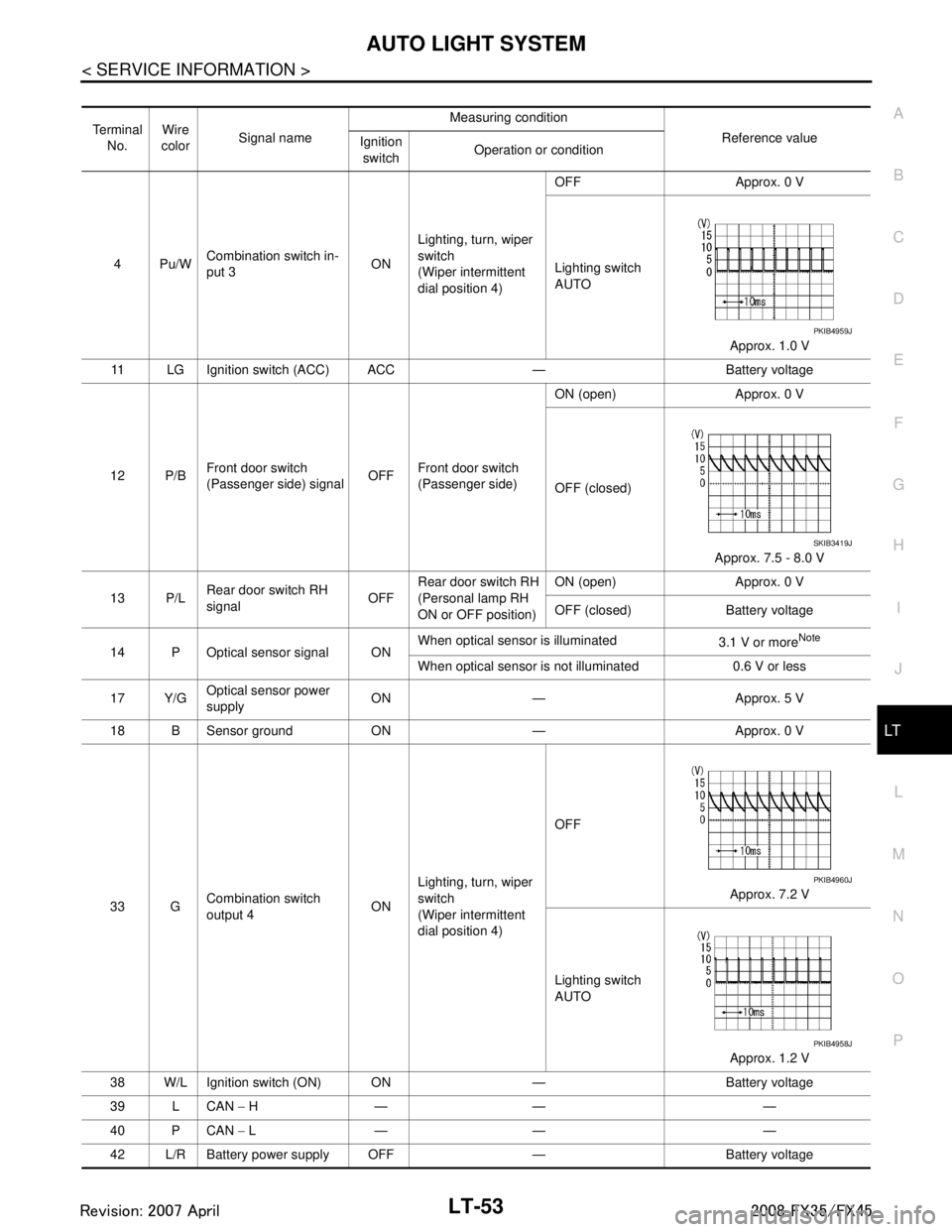
AUTO LIGHT SYSTEMLT-53
< SERVICE INFORMATION >
C
DE
F
G H
I
J
L
M A
B
LT
N
O P
Te r m i n a l No. Wire
color Signal name Measuring condition
Reference value
Ignition
switch Operation or condition
4Pu/W Combination switch in-
put 3
ONLighting, turn, wiper
switch
(Wiper intermittent
dial position 4) OFF Approx. 0 V
Lighting switch
AUTO
Approx. 1.0 V
11 LG Ignition switch (ACC) ACC — Battery voltage
12 P/B Front door switch
(Passenger side) signal OFFFront door switch
(Passenger side) ON (open) Approx. 0 V
OFF (closed)
Approx. 7.5 - 8.0 V
13 P/L Rear door switch RH
signal OFFRear door switch RH
(Personal lamp RH
ON or OFF position) ON (open) Approx. 0 V
OFF (closed) Battery voltage
14 P Optical sensor signal ON When optical sensor is illuminated
3.1 V or more
Note
When optical sensor is not illuminated 0.6 V or less
17 Y/G Optical sensor power
supply ON — Approx. 5 V
18 B Sensor ground ON — Approx. 0 V
33 G Combination switch
output 4 ONLighting, turn, wiper
switch
(Wiper intermittent
dial position 4) OFF
Approx. 7.2 V
Lighting switch
AUTO Approx. 1.2 V
38 W/L Ignition switch (ON) ON — Battery voltage
39 L CAN − H— — —
40 P CAN − L— — —
42 L/R Battery power supply OFF — Battery voltage
PKIB4959J
SKIB3419J
PKIB4960J
PKIB4958J
3AA93ABC3ACD3AC03ACA3AC03AC63AC53A913A773A893A873A873A8E3A773A983AC73AC93AC03AC3
3A893A873A873A8F3A773A9D3AAF3A8A3A8C3A863A9D3AAF3A8B3A8C
Page 3156 of 3924
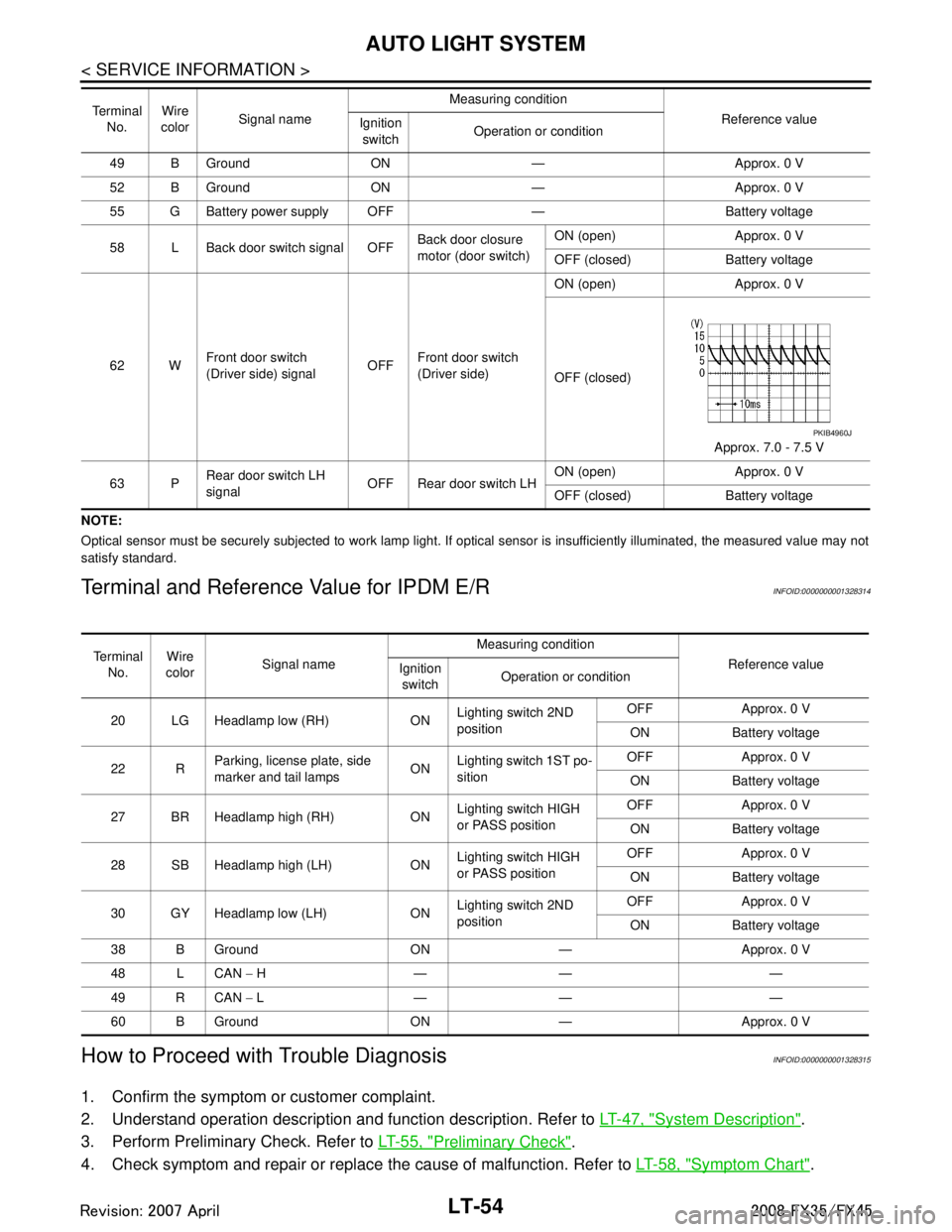
LT-54
< SERVICE INFORMATION >
AUTO LIGHT SYSTEM
NOTE:
Optical sensor must be securely subjected to work lamp light. If optical sensor is insufficiently illuminated, the measured value may not
satisfy standard.
Terminal and Reference Value for IPDM E/RINFOID:0000000001328314
How to Proceed with Trouble DiagnosisINFOID:0000000001328315
1. Confirm the symptom or customer complaint.
2. Understand operation description and function description. Refer to LT-47, "
System Description".
3. Perform Preliminary Check. Refer to LT-55, "
Preliminary Check".
4. Check symptom and repair or replace the cause of malfunction. Refer to LT-58, "
Symptom Chart".
49 B Ground ON — Approx. 0 V
52 B Ground ON — Approx. 0 V
55 G Battery power supply OFF — Battery voltage
58 L Back door switch signal OFF Back door closure
motor (door switch)ON (open) Approx. 0 V
OFF (closed) Battery voltage
62 W Front door switch
(Driver side) signal OFFFront door switch
(Driver side) ON (open) Approx. 0 V
OFF (closed)
Approx. 7.0 - 7.5 V
63 P Rear door switch LH
signal OFF Rear door switch LH ON (open) Approx. 0 V
OFF (closed) Battery voltage
Te r m i n a l
No. Wire
color Signal name Measuring condition
Reference value
Ignition
switch Operation or condition
PKIB4960J
Te r m i n a l
No. Wire
color Signal name Measuring condition
Reference value
Ignition
switch Operation or condition
20 LG Headlamp low (RH) ON Lighting switch 2ND
positionOFF Approx. 0 V
ON Battery voltage
22 R Parking, license plate, side
marker and tail lamps ON
Lighting switch 1ST po-
sition OFF Approx. 0 V
ON Battery voltage
27 BR Headlamp high (RH) ON Lighting switch HIGH
or PASS positionOFF Approx. 0 V
ON Battery voltage
28 SB Headlamp high (LH) ON Lighting switch HIGH
or PASS positionOFF Approx. 0 V
ON Battery voltage
30 GY Headlamp low (LH) ON Lighting switch 2ND
positionOFF Approx. 0 V
ON Battery voltage
38 B Ground ON — Approx. 0 V
48 L CAN − H—— —
49 R CAN − L—— —
60 B Ground ON — Approx. 0 V
3AA93ABC3ACD3AC03ACA3AC03AC63AC53A913A773A893A873A873A8E3A773A983AC73AC93AC03AC3
3A893A873A873A8F3A773A9D3AAF3A8A3A8C3A863A9D3AAF3A8B3A8C
Page 3157 of 3924
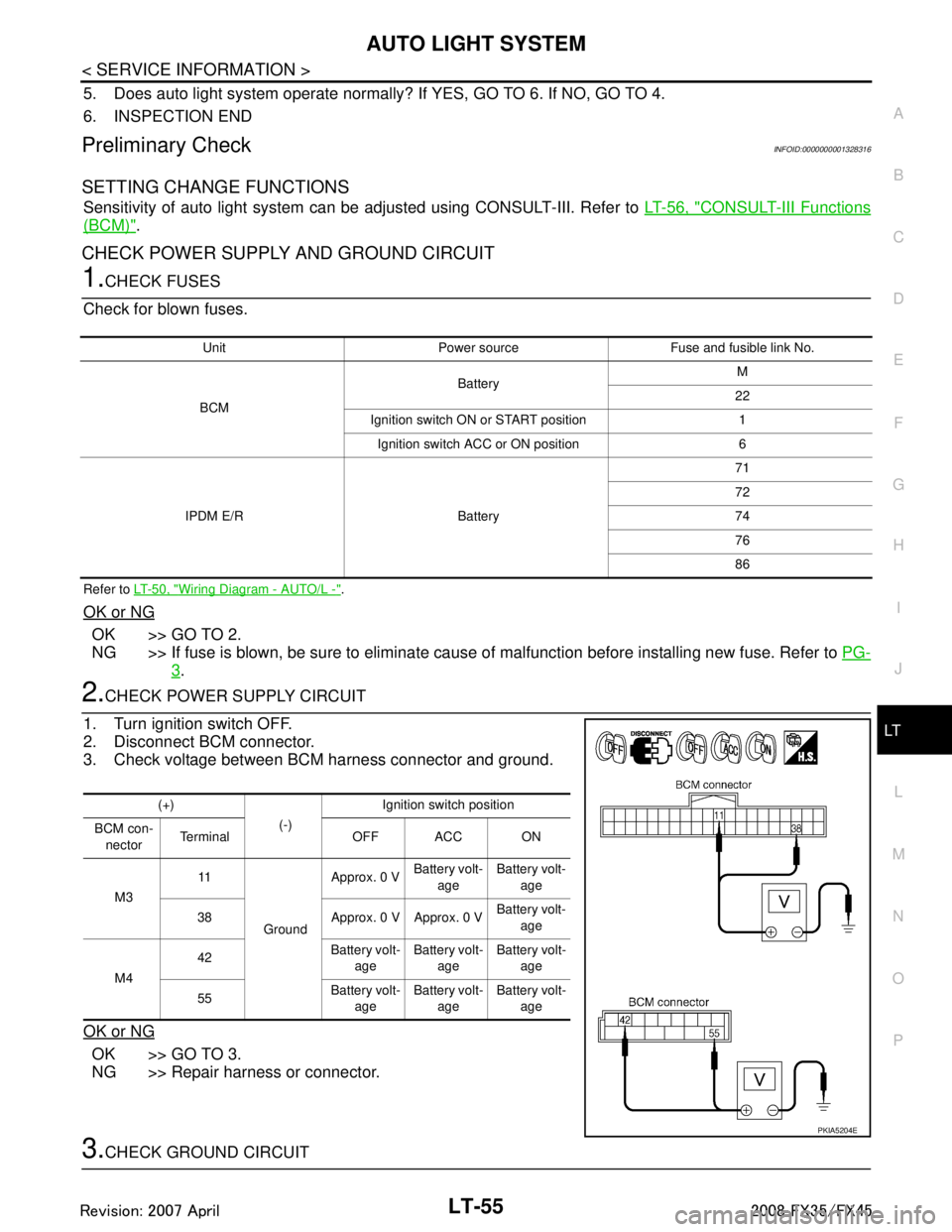
AUTO LIGHT SYSTEMLT-55
< SERVICE INFORMATION >
C
DE
F
G H
I
J
L
M A
B
LT
N
O P
5. Does auto light system operate normally? If YES, GO TO 6. If NO, GO TO 4.
6. INSPECTION END
Preliminary CheckINFOID:0000000001328316
SETTING CHANGE FUNCTIONS
Sensitivity of auto light system can be adjusted using CONSULT-III. Refer to LT-56, "CONSULT-III Functions
(BCM)".
CHECK POWER SUPPLY AND GROUND CIRCUIT
1.CHECK FUSES
Check for blown fuses.
Refer to LT- 5 0 , "Wiring Diagram - AUTO/L -".
OK or NG
OK >> GO TO 2.
NG >> If fuse is blown, be sure to eliminate caus e of malfunction before installing new fuse. Refer to PG-
3.
2.CHECK POWER SUPPLY CIRCUIT
1. Turn ignition switch OFF.
2. Disconnect BCM connector.
3. Check voltage between BCM harness connector and ground.
OK or NG
OK >> GO TO 3.
NG >> Repair harness or connector.
3.CHECK GROUND CIRCUIT
Unit Power source Fuse and fusible link No.
BCM Battery
M
22
Ignition switch ON or START position 1 Ignition switch ACC or ON position 6
IPDM E/R Battery 71
72
74
76
86
(+)
(-)Ignition switch position
BCM con- nector Te r m i n a l O F F A C C O N
M3 11
Ground Approx. 0 V
Battery volt-
age Battery volt-
age
38 Approx. 0 V Approx. 0 V Battery volt-
age
M4 42
Battery volt-
age Battery volt-
age Battery volt-
age
55 Battery volt-
age Battery volt-
age Battery volt-
age
PKIA5204E
3AA93ABC3ACD3AC03ACA3AC03AC63AC53A913A773A893A873A873A8E3A773A983AC73AC93AC03AC3
3A893A873A873A8F3A773A9D3AAF3A8A3A8C3A863A9D3AAF3A8B3A8C
Page 3168 of 3924
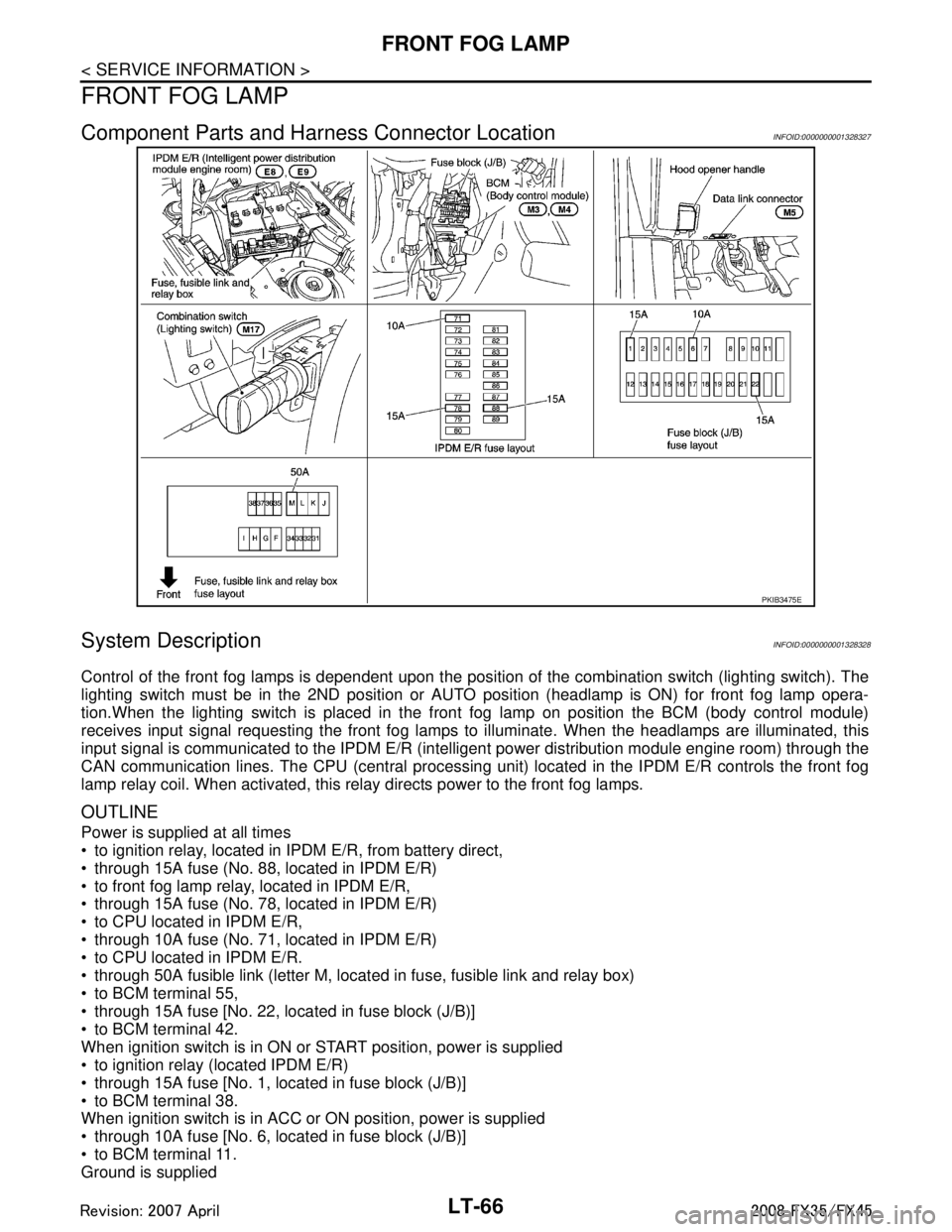
LT-66
< SERVICE INFORMATION >
FRONT FOG LAMP
FRONT FOG LAMP
Component Parts and Harness Connector LocationINFOID:0000000001328327
System DescriptionINFOID:0000000001328328
Control of the front fog lamps is dependent upon the position of the combination switch (lighting switch). The
lighting switch must be in the 2ND position or AUTO position (headlamp is ON) for front fog lamp opera-
tion.When the lighting switch is placed in the front fog lamp on position the BCM (body control module)
receives input signal requesting the front fog lamps to illuminate. When the headlamps are illuminated, this
input signal is communicated to the IPDM E/R (inte lligent power distribution module engine room) through the
CAN communication lines. The CPU (central processing unit) located in the IPDM E/R controls the front fog
lamp relay coil. When activated, this relay directs power to the front fog lamps.
OUTLINE
Power is supplied at all times
to ignition relay, located in IP DM E/R, from battery direct,
through 15A fuse (No. 88, located in IPDM E/R)
to front fog lamp relay, located in IPDM E/R,
through 15A fuse (No. 78, located in IPDM E/R)
to CPU located in IPDM E/R,
through 10A fuse (No. 71, located in IPDM E/R)
to CPU located in IPDM E/R.
through 50A fusible link (letter M, located in fuse, fusible link and relay box)
to BCM terminal 55,
through 15A fuse [No. 22, located in fuse block (J/B)]
to BCM terminal 42.
When ignition switch is in ON or START position, power is supplied
to ignition relay (located IPDM E/R)
through 15A fuse [No. 1, located in fuse block (J/B)]
to BCM terminal 38.
When ignition switch is in ACC or ON position, power is supplied
through 10A fuse [No. 6, located in fuse block (J/B)]
to BCM terminal 11.
Ground is supplied
PKIB3475E
3AA93ABC3ACD3AC03ACA3AC03AC63AC53A913A773A893A873A873A8E3A773A983AC73AC93AC03AC3
3A893A873A873A8F3A773A9D3AAF3A8A3A8C3A863A9D3AAF3A8B3A8C
Page 3169 of 3924
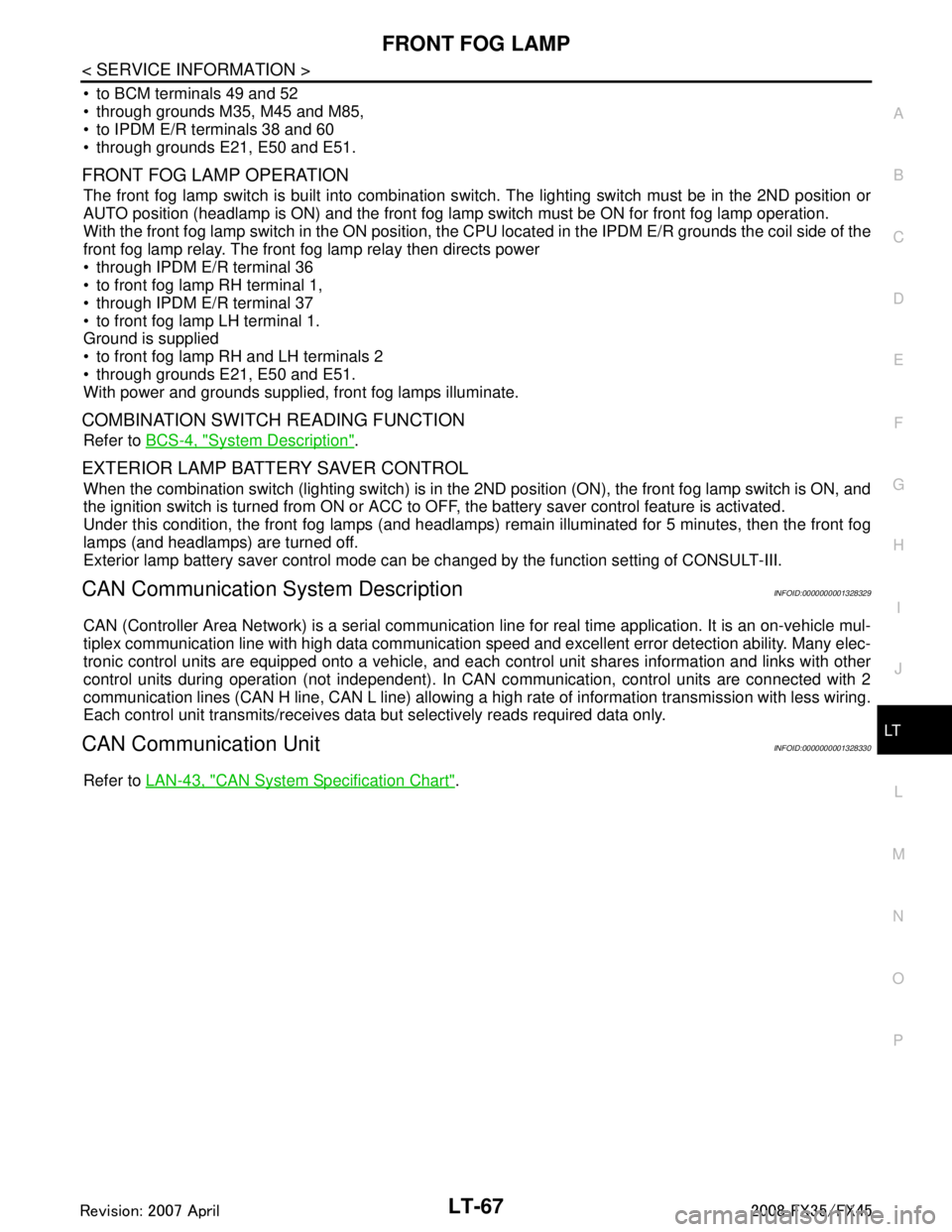
FRONT FOG LAMPLT-67
< SERVICE INFORMATION >
C
DE
F
G H
I
J
L
M A
B
LT
N
O P
to BCM terminals 49 and 52
through grounds M35, M45 and M85,
to IPDM E/R terminals 38 and 60
through grounds E21, E50 and E51.
FRONT FOG LAMP OPERATION
The front fog lamp switch is built into combination s witch. The lighting switch must be in the 2ND position or
AUTO position (headlamp is ON) and the front fog lamp switch must be ON for front fog lamp operation.
With the front fog lamp switch in the ON position, t he CPU located in the IPDM E/R grounds the coil side of the
front fog lamp relay. The front fog lamp relay then directs power
through IPDM E/R terminal 36
to front fog lamp RH terminal 1,
through IPDM E/R terminal 37
to front fog lamp LH terminal 1.
Ground is supplied
to front fog lamp RH and LH terminals 2
through grounds E21, E50 and E51.
With power and grounds supplied, front fog lamps illuminate.
COMBINATION SWITCH READING FUNCTION
Refer to BCS-4, "System Description".
EXTERIOR LAMP BATTERY SAVER CONTROL
When the combination switch (lighting switch) is in the 2ND position (ON), the front fog lamp switch is ON, and
the ignition switch is turned from ON or ACC to OF F, the battery saver control feature is activated.
Under this condition, the front fog lamps (and headlamps ) remain illuminated for 5 minutes, then the front fog
lamps (and headlamps) are turned off.
Exterior lamp battery saver control mode can be changed by the function setting of CONSULT-III.
CAN Communication System DescriptionINFOID:0000000001328329
CAN (Controller Area Network) is a serial communication li ne for real time application. It is an on-vehicle mul-
tiplex communication line with high data communication speed and excellent error detection ability. Many elec-
tronic control units are equipped onto a vehicle, and each control unit shares information and links with other
control units during operation (not independent). In CAN communication, control units are connected with 2
communication lines (CAN H line, CAN L line) allowing a high rate of information transmission with less wiring.
Each control unit transmits/receives data but selectively reads required data only.
CAN Communication UnitINFOID:0000000001328330
Refer to LAN-43, "CAN System Specification Chart".
3AA93ABC3ACD3AC03ACA3AC03AC63AC53A913A773A893A873A873A8E3A773A983AC73AC93AC03AC3
3A893A873A873A8F3A773A9D3AAF3A8A3A8C3A863A9D3AAF3A8B3A8C
Page 3172 of 3924
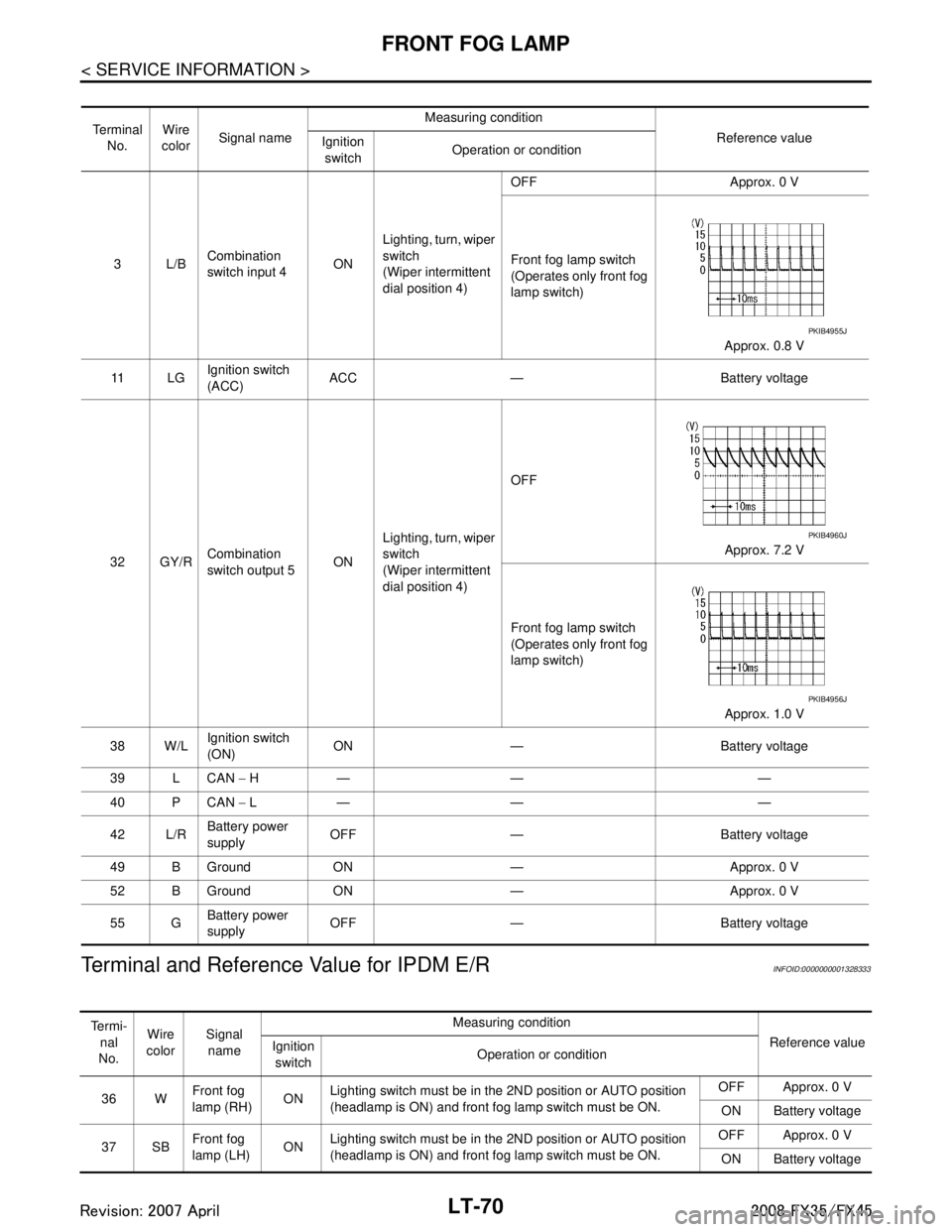
LT-70
< SERVICE INFORMATION >
FRONT FOG LAMP
Terminal and Reference Value for IPDM E/R
INFOID:0000000001328333
Te r m i n a l No. Wire
color Signal name Measuring condition
Reference value
Ignition
switch Operation or condition
3L/B Combination
switch input 4
ONLighting, turn, wiper
switch
(Wiper intermittent
dial position 4) OFF Approx. 0 V
Front fog lamp switch
(Operates only front fog
lamp switch)
Approx. 0.8 V
11 L G Ignition switch
(ACC)
ACC — Battery voltage
32 GY/R Combination
switch output 5 ONLighting, turn, wiper
switch
(Wiper intermittent
dial position 4) OFF
Approx. 7.2 V
Front fog lamp switch
(Operates only front fog
lamp switch) Approx. 1.0 V
38 W/L Ignition switch
(ON)
ON — Battery voltage
39 L CAN − H— — —
40 P CAN − L— — —
42 L/R Battery power
supply OFF — Battery voltage
49 B Ground ON — Approx. 0 V
52 B Ground ON — Approx. 0 V
55 G Battery power
supply OFF — Battery voltage
PKIB4955J
PKIB4960J
PKIB4956J
Te r m i -
nal
No. Wire
color Signal
name Measuring condition
Reference value
Ignition
switch Operation or condition
36 W Front fog
lamp (RH)
ONLighting switch must be in the 2ND position or AUTO position
(headlamp is ON) and front fog lamp switch must be ON. OFF Approx. 0 V
ON Battery voltage
37 SB Front fog
lamp (LH)
ONLighting switch must be in the 2ND position or AUTO position
(headlamp is ON) and front fog lamp switch must be ON. OFF Approx. 0 V
ON Battery voltage
3AA93ABC3ACD3AC03ACA3AC03AC63AC53A913A773A893A873A873A8E3A773A983AC73AC93AC03AC3
3A893A873A873A8F3A773A9D3AAF3A8A3A8C3A863A9D3AAF3A8B3A8C
Page 3173 of 3924
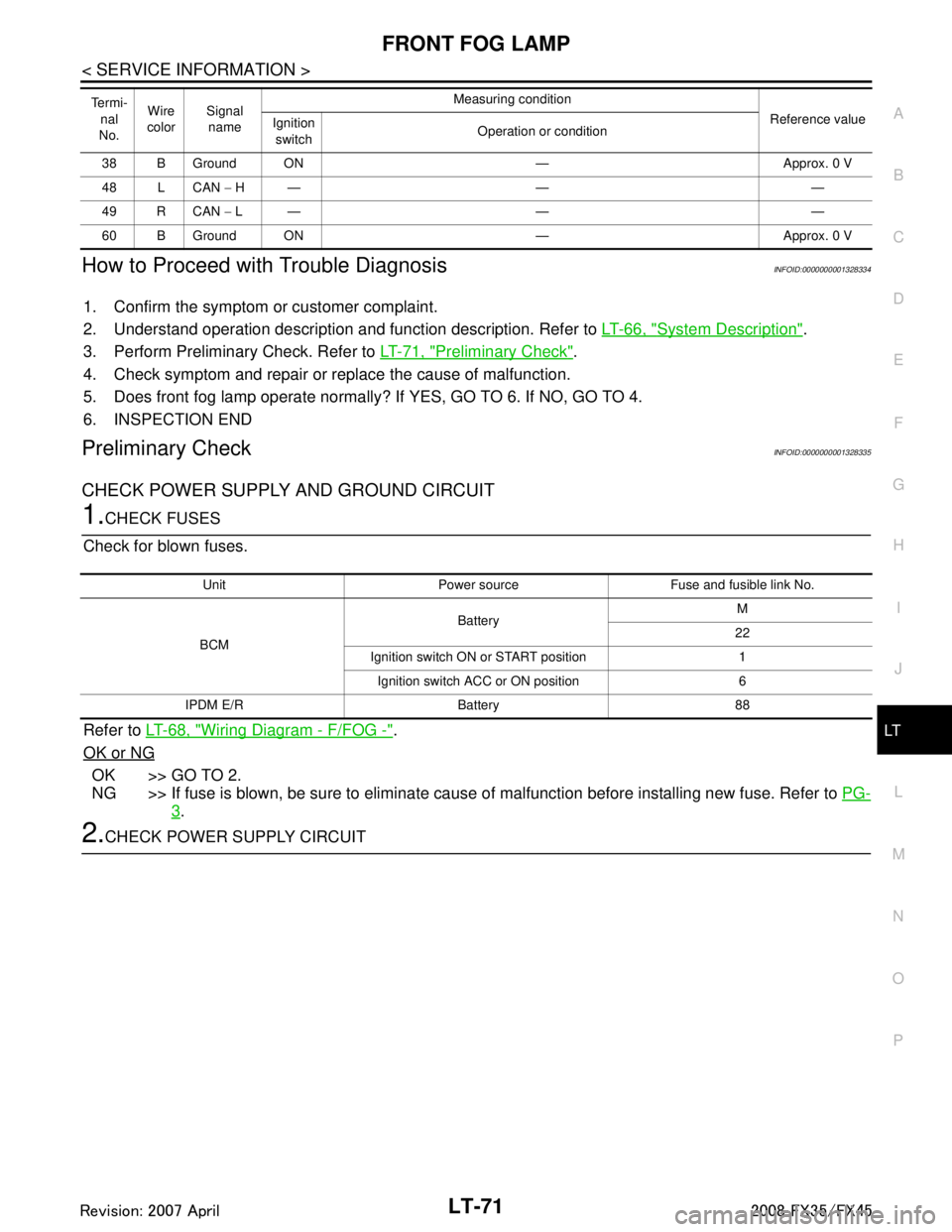
FRONT FOG LAMPLT-71
< SERVICE INFORMATION >
C
DE
F
G H
I
J
L
M A
B
LT
N
O P
How to Proceed with Trouble DiagnosisINFOID:0000000001328334
1. Confirm the symptom or customer complaint.
2. Understand operation description and function description. Refer to LT-66, "
System Description".
3. Perform Preliminary Check. Refer to LT-71, "
Preliminary Check".
4. Check symptom and repair or replace the cause of malfunction.
5. Does front fog lamp operate normally? If YES, GO TO 6. If NO, GO TO 4.
6. INSPECTION END
Preliminary CheckINFOID:0000000001328335
CHECK POWER SUPPLY AND GROUND CIRCUIT
1.CHECK FUSES
Check for blown fuses.
Refer to LT-68, "
Wiring Diagram - F/FOG -".
OK or NG
OK >> GO TO 2.
NG >> If fuse is blown, be sure to eliminate caus e of malfunction before installing new fuse. Refer to PG-
3.
2.CHECK POWER SUPPLY CIRCUIT
38 B Ground ON — Approx. 0 V
48 L CAN − H— — —
49 R CAN − L— — —
60 B Ground ON — Approx. 0 V
Te r m i -
nal
No. Wire
color Signal
name Measuring condition
Reference value
Ignition
switch Operation or condition
Unit Power source Fuse and fusible link No.
BCM Battery
M
22
Ignition switch ON or START position 1 Ignition switch ACC or ON position 6
IPDM E/R Battery 88
3AA93ABC3ACD3AC03ACA3AC03AC63AC53A913A773A893A873A873A8E3A773A983AC73AC93AC03AC3
3A893A873A873A8F3A773A9D3AAF3A8A3A8C3A863A9D3AAF3A8B3A8C